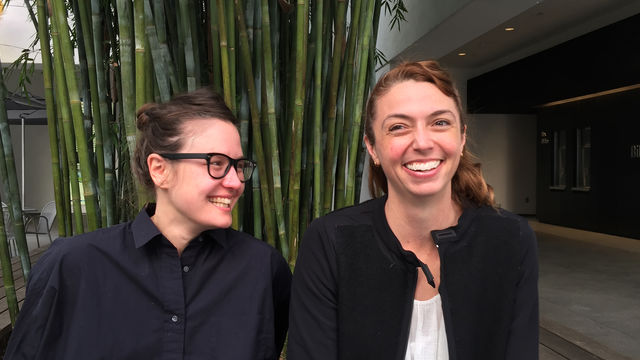
Bureau of Feminism Spring Residency: Jen Kennedy and Liz Linden
Public Engagement artists-in-residence Jen Kennedy and Liz Linden are investigating the language of feminism, as part of the Hammer’s Bureau of Feminism initiative. Their residency will culminate in an online exhibition of contemporary perceptions around the shared, cultural movement called feminism. Over the course of the coming weeks, they will lead two reading groups to probe journalistic bias through examination of the New York Times, and stage a participatory performance called TELETHON on March 4. In advance of these programs, January Parkos Arnall, organizing curator of the residency, met with Kennedy and Linden to discuss their work.
JPA: How did the two of you meet and begin working together?
We attended a number of the same symposia on feminism at New York City museums around 2007, but then actually met in 2008 when we both participated in the Whitney Independent Study Program.
We realized we had both been troubled by the same thing in those public discussions—that in some cases, chances at real dialogue between speakers and panelists had been lost because it was as if they were using different languages. When one person said “feminism” they meant one thing, while another person used it to signify something else. That these semiotic differences weren’t addressed explicitly meant that speakers were not forced to contend with or even recognize these differences, and they essentially talked past one another without intending to. It seemed clear that the differences in meaning are significant, in theory and in practice, because they are where the possibilities for coalition building arise. We felt that in order to discuss and do feminism in meaningful ways, we needed to attend to the malleability, instability, and complexity of the word itself.
Our collaboration started because we both wanted to have a conversation in which these differences were the subject, in order to help create more clarity in the broader conversation about feminism going forward. At the time, we couldn’t find this conversation about language happening anywhere, and even though we worried about the way our own positions (as twenty-something cis-gendered middle-class white women in heterosexual relationships) might over-determine the discussion, the conversation seemed urgent enough to us that we started it anyway. Now, as then, we work hard to make clear that our work is not about exploring our ideas of what “feminism” is or should be; it's about what it means to each of us, to all of us who say it.
JPA: What is something you have learned over the course of making this work?
One thing we learned very early on was just that asking people “How do you define 'feminism’?” simply wasn’t going to work. It’s such a difficult question for most of us to answer.
Our first project back in 2009 tried to get at the signification of “feminism” directly, and we learned a lot from the ways that work failed. It was a language game, complete with a “Dictionary of Temporary Approximations,” all intended to get public participants to define what they meant when they said “feminism.” For a number of reasons the game was almost impossible to play. One thing we realized in that project (which probably seems obvious now) is simply that it is much more productive to approach the question of meaning indirectly, for example, by addressing it obliquely in a question like, “What in this newspaper strikes you as feminist?” Or, by asking for a less definitive and more knee-jerk response, as in, “What is the first thing that comes to mind when you hear the word ‘feminism’?"
JPA: Feminism can often be considered a “dirty word” in its historic neglect of the needs of people of color. How do you hope to address this through your work considering the semiotics of feminism?
One thing we try to do with the project is create platforms that are open to the widest possible interpretations of the word, so that we, the public, can see the diversity of meanings the word has for people, and therefore grapple with its significations, positive and negative. That it is for some people a “dirty word” and for others something to be celebrated, points to the urgency of making those differences visible. These are differences of opinion but they are also differences of gender, sex, sexuality, age, race, ability, class, and so on. How can we, as communities or cultures, recognize and attend to differences by treating them as generative rather than divisive?
JPA: We are living in a very different political climate than the one in which you began doing this work. How can the ideas behind feminism help in the face of impending attacks on freedom and equal rights today?
Most of our projects are about asking questions and listening, and considering how those acts can be used as intersectional feminist practices. For example, exploring how we can ask questions to get answers that we don’t already know; to learn about experiences and positions that we might not immediately see from the social, cultural, class, gendered, racial, etc. positions we occupy. Connected to this are further questions: How can we create situations where these questions can be asked by and of as diverse a group of people as possible? How can we create conversations where people will be surprised by what they hear?
Asking questions and listening might seem very simple, but it can be challenging and constructive for us precisely because it allows us to hear things that call into question one's position. Our work is built on a belief that an awareness of one's blind spots emerges out of conversations and collaboration, without which one cannot see beyond the limitations of one’s own frame of reference or practice truly intersectional feminism.




